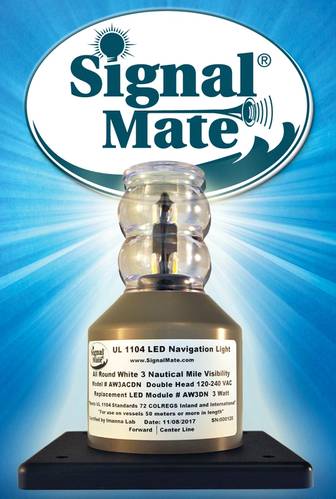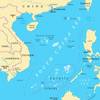SAFETY: Transitioning to LED Navigation Lights
The Convention on the International Regulations for Preventing Collisions at Sea (COLREGS) governs the intensity of navigation lights, requiring a minimum intensity in candelas according to a prescribed intensity formula. Changes are coming.
IMO Resolution MSC.253 (83) for larger vessels sets performance standards for navigation lights, navigation light controller and associated equipment, requiring a masthead light, sidelights and a stern light installed on board a ship not less than 50 meters in length should be duplicated or be fitted with duplicate lamps, and that navigation light controllers be fitted onboard vessels to provide means of control and monitoring of the status of navigation lights onboard the vessel.
MSC.253 (83) 4.3 provides for special requirements for lights using LEDs. In fact, the luminous intensity of LEDs gradually decreases while the electricity consumption remains unchanged. The rate of decrease of luminous intensity depends on the output of LEDs and temperature of LEDs. To prevent shortage of luminous intensity of LEDs:
- An alarm function should be activated to notify the Officer of the Watch that the luminous intensity of the light reduces below the level required by COLREGS; or
- LEDs should only be used within the lifespan (practical term of validity) specified by the manufacturer to maintain the necessary luminous intensity of LEDs.
New Equipment, New Challenges
In other words, the resolution 4.3 provides two choices for LED navigation lights: An operator can either monitor intensity; or, alternatively, specify lifespan (count hours). The problem with specifying the lifespan (counting hours) of the LED navigation light is that there is no way of determining if the LED navigation light is maintaining COLREGS intensity requirements for the lifespan of the light. The only way to know if COLREGS intensity is being maintained is to monitor the intensity of the LED.
LED marine navigation lights are gaining popularity due to their energy efficiency and long lifetime, but LEDs present special problems that compel special requirements for navigation lights using LEDs. There needs be an alarm to notify the Officer of the Watch that the luminous intensity of the light has been reduced below the level required by COLREGS.
The intensity of conventional incandescent lights depends on electrical current, and so conventional navigation control panels monitor current and trigger an alarm when they detect an open filament. The challenge is that LED navigation lights do not fail the same way as do incandescent navigation lights. With LED navigation lights, the intensity diminishes over time but without a reduction in current. Therefore, conventional navigation control panels cannot detect a non-compliant LED navigation light that does not meet the COLREGS requirement.
This is becoming an issue as more passenger vessels and large vessels are converting from incandescent to LED navigation lights while keeping their conventional navigation control panels designed for incandescent lights. There is no easy way to properly modify an incandescent control panel for the lower currents of the LED navigation light to prevent false triggering of the alarm without modifying the control panel circuitry. A more expensive option is to replace the original control panel entirely with a new one designed for LED navigation lights. Nevertheless, neither a new nor a modified control panel will detect non-complaint LED navigations light due to the decrease of LED intensity without any decrease of current.
Benchmarking the Solutions
Most manufacturers of LED navigation lights that are required to meet MSC.253 (83) choose 4.3.2 to provide a lifespan of 50,000 hours and then replacement of the light is required. One manufacturer monitors the temperature of the light to either speed up or slow down the internal clock that counts the hours of life. This is done to attempt to estimate the life of the LED based on temperatures in the lab, but it is not useful in determining the LED intensity is compliant. LEDs can have a diminished intensity for several reasons (thermal management, electronic components, and thermal adhesives).
Another manufacturer’s method addresses the MSC.253(83) 4.3.2 requirement by increasing the current to the LED at predetermined intervals to make up for any degradation of the LED intensity during the 50,000 hours before replacement of the light is required. Since the temperature of the LEDs (proper thermal management) is the most important factor in determining longevity, arbitrarily continuing to increase the current to the LED, thus raising the temperature of the LED, may actually cause the LED intensity to prematurely diminish below COLREGS, without notifying of a non-compliant LED navigation light.
Both methods do adhere to MSC.253 (83)4.3.2, but neither method notifies if the LED intensity has not maintained COLREGS requirements.
Viable Alternatives
A self-monitoring LED navigation light that simulates an open filament (when non-compliant) by turning off the current to the light to trigger the existing alarm panel into seeing it as an incandescent light with an open filament, will send appropriate alarms. Signal Mate offers a UL1104 LED navigation light certified by a Coast Guard recognized testing laboratory to IMO MSC.253 (83)4.3 that monitors LED intensity and activates an alarm function to notify the Officer of the Watch of non-compliant LED intensity. Since the light monitors LED intensity, the light can be used regardless of the hours of use. Signal Mate also keeps track of hours of use to indicate the approaching end of life, notifying users that it is time to purchase a replacement LED module. Because of its modular design, the whole light does not need to be replaced; just the LED module.
Looking Ahead
IMO MSC 253(83) 4.3 addressed the concerns of the reduction of LED intensity for navigation lights for vessels over 50 meters. Similarly for inland vessels, USCG is also addressing the concerns of reduction of LED intensity over time, for navigation lights for inspected vessels over 65 feet, and is currently updating the UL1104 standard with ABYC. The UL1104 standard produced in 1998 was for incandescent navigation lights. Since that time technology has changed and the UL1104 standard is being updated to addresses the concerns of LED navigation lights.
It appears that USCG is taking a different approach than the IMO MSC.253 (83) which gives a choice to either monitor LED intensity or provide practical terms of validity (lifespan). The Marine Safety Center Technical Note MTN 01-18 that provides guidance for UL1104 LED navigation lights states “These lights must have a means of detecting and signaling a light that is degraded,” and “All LED Lights must have a bulb life of at least 500 hours.” MTN 01-18 is the first phase of the changes.
At the ABYC Standards Week & Annual Meeting in Seattle January 7-11, 2019; USCG concerns and changes were to be addressed with the committee, but unfortunately, the coast Guard was not present due to the government shutdown. A subcommittee was formed to address some of the issues that were presented during the meeting. The rewriting of UL1104 navigation lights will be addressed at the next meeting.
There is also progress moving forward with the National Shipbuilding Research Program (NSRP) and the Navy regarding advances in navigation lighting and control panels. Moreover, there is current interest in a NSRP Panel Project to investigate the new lighting and control technologies for navigation lights to replace the legacy lights currently in use. Stay tuned. www.SignalMate.com
This article first appeared in the June 2019 print edition of MarineNews magazine.




















